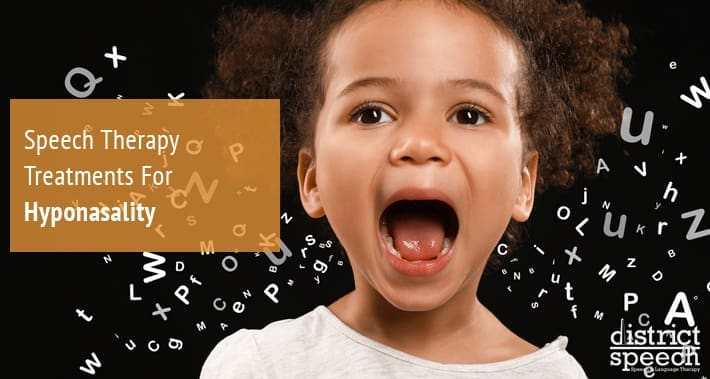
Hyponasality is a type of resonance disorder that affects the way that you speak.
It is often caused by a lack of sound resonance in your nasal cavity, which can make you sound stuffed up.
Hyponasality can have a variety of causes that boil down to two types: structural or functional.
Speech therapy is a great solution if your hyponasality is created from a functional cause because that means that is a learned behavior that can be corrected.
If your child seems to often sound stuffed up, a pediatric speech therapist can help.
However, since this condition can also be seen in adults, speech therapy can help if you have hyponasality as well.
Either way, consider contacting a speech therapy clinic to book an assessment – speech therapy for resonance disorders can be quite effective.
But for now, let’s find out more about what hyponasality is.
What Is Hyponasality?
Hyponasality is a type of resonance disorder that can result from too little nasal sound energy when speaking.
But what’s a resonance disorder?
Perhaps unsurprisingly based on the name, it’s a disorder related to resonance – the way the vibrations of speech reverberate within your body.
It’s important to remember that resonance is a function of sound, not airflow.
Hyponasality happens when there is not enough nasal resonance on nasal sounds due to a blockage in the nasal cavity.
Contrast this with hypernasality, where there’s too much nasality.
Hyponasality Signs
You’ll notice that if hyponasality is present, there will be reduced nasal resonance on spoken vowels, sonorants, and nasal consonants.
In severe cases, hyponasality can occur alongside the denasalization of nasal consonants.
In particular the speech sounds that come with m, n, and -ing become distorted to the point where they no longer resemble the original.
M often becomes b, n often becomes d, and ing just becomes ig.
What Causes Hyponasality?
Hyponasality, like all resonance disorders, have either structural or functional causes.
Structural causes typically require surgery to correct, while functional causes are learned behaviors.
Structurally, it can be caused by a nasal cavity obstruction which can be caused by a variety of anomalies in the formation of your head.
This is the case with conditions like velopharyngeal insufficiency or cleft lip and cleft palate.
It can also be caused structurally by swelling due to hypertrophic tonsils or a deviated septum, or due to temporary conditions like a cold or seasonal allergies.
Functional examples include problems with motor planning execution often caused by apraxia of speech, which creates incomplete closures on nasal letter sounds.
Finally, if you are hearing impaired, the lack of auditory feedback can result in hyponasality sounds.
Assessing For Hyponasality
The goal when assessing for hyponasality is to figure out if medical intervention or speech therapy is the best way to approach your hyponasality.
The first step if you think you might have a resonance disorder is do a speech and hearing screening.
This screening is conducted by a speech therapist and does not diagnose a resonance disorder, but identifies the need for a comprehensive assessment.
This comprehensive assessment is what could lead to a resonance disorder diagnoses.
It will consider:
- any impairment in your body structure and function
- any present conditions like developmental disabilities or hearing loss
- any limitations in activity and participation in any communication contexts
- any contextual factors that can affect communication
- any impact of communication impairment on quality of life considerations
The assessment will also take into account any language norms that may influence you, like if English is your second language, whether you’ve received accent modification speech therapy or any other speech therapy treatments, as well as if you’re deaf or hard of hearing.
This is because if you’re deaf or hard of hearing, it may seem as though you have a resonance disorder like hyponasality which is the result of a lack of auditory feedback.
It is not actually a resonance disorder in the true sense.

How Can Speech Therapy For Hyponasality Help?
If the result of your comprehensive assessment is that speech therapy can help to reduce your hyponasality, then that’s good news.
This is because there are a lot of different strategies your speech therapist can use to help you.
It also means that your hyponasality is not due to any structural causes, but instead due to misarticulation or functional causes.
Speech therapy can help you to improve how you make speech sounds, which will improve your resonance.
Some strategies your therapist could use include:
- Teaching you how to adjust your articulation placement on affected sounds to reduce the perception of resonance
- Teaching you to modify your speech in order to compensate for your resonance disorder by speaking clearly, loudly, or slowly
- Resistance treatment which involves speaking through continuous positive airway pressure to improve your speech muscles
Book Your Appointment With District Speech Today
As you can see, there’s a wide variety of speech therapy approaches available if you have hyponasality that has a functional cause.
It’s also worth noting that speech therapy is very helpful if you’ve had surgery to correct the structural cause of your hyponasality.
There are speech therapists who can help teach you how to speak effectively post-surgery, because there is always a learning curve that follows a structural adjustment.
District Speech has a team of speech therapists ready to help.
Book your appointment with District Speech to get started and schedule an evaluation today.
1300 I St NW, Suite 400 E,
Washington, DC 20005
- https://g.page/districtspeech
District Speech and Language Therapy specializes in speech therapy, physical therapy, and occupational therapy solutions, for both children and adults, in the Washington D.C and the Arlington Virginia areas.